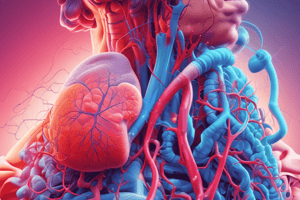Podcast
Questions and Answers
What is the main function of ventilation?
What is the main function of ventilation?
- To move air into and out of the lungs (correct)
- To load oxygen onto hemoglobin molecules
- To facilitate oxygen diffusion across membranes
- To remove waste products from the body
What is the role of partial pressure in oxygen diffusion?
What is the role of partial pressure in oxygen diffusion?
- It reduces cardiac arrest risk
- It increases exhalation rate
- It plays a crucial role in oxygen diffusion across membranes (correct)
- It helps in oxygen loading onto hemoglobin
Which process involves exchanging oxygen and carbon dioxide at the cellular level?
Which process involves exchanging oxygen and carbon dioxide at the cellular level?
- Oxygenation
- Ventilation
- Regulation of ventilation
- Respiration (correct)
What leads to irreversible brain damage in cases of cardiac arrest?
What leads to irreversible brain damage in cases of cardiac arrest?
Which system controls breathing rate, depth, and rhythm?
Which system controls breathing rate, depth, and rhythm?
What is one of the early signs of hypoxia?
What is one of the early signs of hypoxia?
Study Notes
- The respiratory and cardiovascular systems work together to supply oxygen and nutrients to every cell and remove waste products.
- In cases of cardiac arrest, irreversible brain damage can occur after just 10 minutes of complete lack of circulation.
- Ventilation is the active process of moving air into and out of the lungs through inhalation, which involves the contraction of the diaphragm and intercostal muscles.
- Partial pressure, measured in millimeters of mercury, plays a crucial role in oxygen diffusion across membranes.
- Exhalation is a passive process that does not require muscular effort, where relaxation of muscles increases intrapulmonary pressure for air to be exhaled.
- Regulation of ventilation involves a complex system based on pH changes in the blood and cerebral spinal fluid, not just oxygen levels.
- Oxygenation is the process of loading oxygen onto hemoglobin molecules in the bloodstream, different from ventilation but essential for internal respiration.
- Respiration involves exchanging oxygen and carbon dioxide at the cellular level through diffusion, with external respiration happening in the lungs and internal respiration occurring in the cells.
- Neural control of breathing originates in the brain and brainstem, with the medullary respiratory centers controlling breathing rate, depth, and rhythm.
- Hypoxia, caused by low oxygen levels, can lead to tissue damage and presents with early signs like restlessness and late signs like cyanosis.
- Ventilation-perfusion (VQ) mismatch can cause abnormalities in gas exchange, where inadequate perfusion leads to less oxygen absorption and carbon dioxide removal.
Studying That Suits You
Use AI to generate personalized quizzes and flashcards to suit your learning preferences.
Description
Test your knowledge on the respiratory and cardiovascular systems, including topics like ventilation, oxygenation, regulation of ventilation, and neural control of breathing. Learn about key concepts such as partial pressure, hypoxia, and ventilation-perfusion mismatch.




